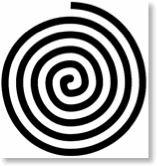Spirals and Wolves


Let’s start with a
different chain of justly tuned
perfect fifths (see my
previous blog
entry):
Eb-Bb-F-C-G-[D]-A-E-B-F#-C#-G#
This chain has [D] as the starting point and fifths
are calculated moving both clockwise and
counterclockwise from it.
Why [D]? Because doing so we have 3 white notes on
each side of the chain before encountering black
notes (I refer to the black and white notes of a
piano keyboard)
So what? Traditionally the idea has always been to
give tuning priority to keys based on white notes so,
starting on [D] we make sure that those fifths close
to the starting point will be justly tuned and if we
have to make some adjustments, those will appear on
seldom used ones (on black keys).
We have already seen that if we keep stacking justly
tuned perfect fifths and we want to fit them inside
one octave, after 11 of them, the 12th will not match
the starting point (by one Pythagorean comma): a
tempered fifth measures
700 cents, a just one 701.955
cents. If we multiply the difference between the 2
fifths times 12 (as the notes of a
chromatic scale) we get:
1.955*12=23.46 (the size of a Pythagorean comma).
So the 12th fifth (in order to fit within an octave)
will have to be:
701.955 - 23.46 = 678.495 cents
This flat fifth is often called a
“wolf fifth” (because it reminds
of the howling of a wolf). Have you ever heard
such an interval?
EXAMPLE #1: Single notes

(click on the
image to watch the movie)
We move along the above mentioned chain of justly
tuned perfect fifths (and relative inversions, just
perfect fourths, 498.045 cents).
Do you hear the wolf interval? It is between G# and
Eb.
Does it sound like a howling wolf?
This interval should be called augmented third that
in equal temperament equals a perfect fourth (500
cents).
Our wolf fourth measures 521.505 cents (a justly
perfect fourth + a Pythagorean comma!) because it is
the inversion of the wolf fifth (521.505 + 678.495 =
1200 cents = 1 octave!)
EXAMPLE #2: Double notes

(click on the
image to watch the movie)
Same progression but with double notes (simultaneous
justly tuned perfect fourths and fifths except for
the wolf fifth G#-Eb, that should be called
diminished sixth)
Is it easier to hear the wolf interval?
EXAMPLE #3: Double notes again

(click on the
image to watch the movie)
Same progression but lower inversion, with double
notes (simultaneous justly tuned perfect fourths and
fifths except for the wolf fourth Eb-G#)
Does the lower register make a difference perceiving
the wolf interval?
The sequence ends with 2 notes a Pythagorean comma
apart.


